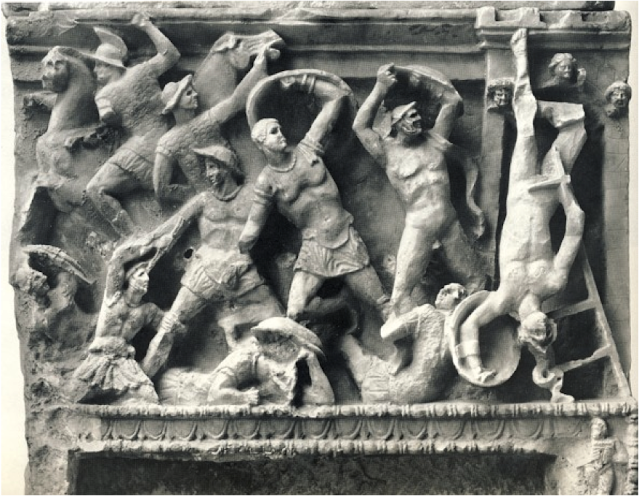Adrastus was a king of Argos, and leader of the Seven against Thebes. He was said to be the founder of the Nemean Games, had hero cults at Sicyon, Megara, and Colonus, and was depicted in works of art from as early as the 6th century BCE. Adrastus is mentioned as early as Homer's Iliad, figures prominently in the poetry of Pindar, and is a main character in Euripides' The Suppliants.
From the lyric poets Bacchylides and Pindar we first hear that Adrastus was the son of Talaus, who according to Apollonius of Rhodes was an Argonaut. Adrastus was the owner of the fabulously fast horse Arion, who was the offspring of Poseidon and Demeter when they mated in horse form. Adrastus was given Arion by Heracles, and the horse saved Adrastus' life during the war of the Seven against Thebes, when all the other champions of the expedition were killed.
The war of the Seven against Thebes resulted from a quarrel between Oedipus' sons Polynices and Eteocles over the kingship of Thebes, which left Eteocles on the throne, and Polynices in exile. One night, Polynices arrived at Adrastus' palace seeking shelter. He found a place to sleep, but soon after Tydeus, the exiled son of the Calydonian king Oeneus, also arrived seeking shelter, and the two began to fight over the same space. When Adrastus discovered Polynices and Tydeus fighting like wild beasts (or in later accounts when he saw that Polynices wore the hide of a lion and that Tydeus wore the hide of a boar, or that they had those animals on their shields), he remembered an oracle of Apollo that said he should marry his daughters to a lion and a boar. So Adrastus gave his daughters, Argia to Polynices, and Deipyle to Tydeus, and promised to restore them to their kingdoms, beginning with Polynices.
Adrastus proceeded to assemble a large Argive army to attack Thebes, appointing seven champions to be its leaders. These became known as the Seven against Thebes. As foretold by a seer, the expedition ended in disaster at Thebes. All of the champions perished, except for Adrastus who was saved by the speed of his divine horse Arion. Creon, who with the death of Eteocles became the new ruler of Thebes, forbade the burial of the expeditions' dead. Athenian tradition held that Theseus, the king and founder-hero of Athens, assisted Adrastus in recovering the bodies of his fallen comrades.
Ten years after the failed expedition against Thebes, to avenge their father's deaths, the sons of the fallen Seven, who were called the Epigoni ("Afterborn"), marched again on Thebes. Adrastus accompanied them on this second Theban expedition, called the war of the Epigoni. This time (according to Pindar) the omens foretold success for the expedition, but death for Adrastus' son Aegialeus. According to Hyginus, as Adrastus was the only one of the Seven to survive the first expedition, his son Aegialeus was the only one of the Epigoni to die in the second. According to Pausanias, the Megarians said that Adrastus, leading the Argive army home after taking Thebes, died at Megara of old age and grief for the death of his son.
Of Adrastus, Pindar writes "I shall exalt the hero with fame-bringing honors." He goes on to describe the ill-fated expedition:
"...they led an army of men to seven-gated Thebes, on a journey with no favorable omens, and Cronus’ son brandished his lightning and urged them not to set out, recklessly from home, but to forgo the expedition. But after all, the host was eager to march, with bronze weapons and cavalry gear, into obvious disaster, and on the banks of the Ismenus, they laid down their sweet homecoming and fed the white-flowering smoke with their bodies, for seven pyres feasted on the men’s young limbs."
Adrastus appears in vase paintings as early as the late 6th century BCE. Pausanias reports seeing Adrastus depicted on the Amyclae Throne of Apollo (6th century BCE) and a monument at Delphi dating to the 450s BCE. Adrastus was found in a scene on a shield strap from Olympia as well. The hero makes the leap to Etruria and, along with four of the seven champions, appears on an Etruscan gem dated to the 5th century BCE. Centuries later, Adrastus is described by Virgil in the Aeneid where Aeneas encounters the pale shade of Adrastus in the underworld. Late 4th or early 5th century CE Roman grammarian, Maurus Servius Honoratus, in his commentaries on the works of Virgil, explains the pallor of Adrastus as a result of seeing the deaths of the seven at Thebes. Thereafter, the phrase "pallor of Adrastus" became a proverbial reference.
 |
| Antigone with Polynices' Body by Sebastien Norblin, 1825 CE, Paris, Ecole Nationale Supérieure des Beaux-Art courtesy of Wikimedia Commons. |
 |
| The Oath of the Seven Chiefs against Thebes, 1800, by Anne-Louis Girodet de Roucy-Trioson, chalk on paper, at the Cleveland Art Museum. |
 |
| Terracotta amphoriskos (flask) depicting Adrastos in his chariot, Attic, ca. 420 B.C.E. at the Metropolitan Museum of Art in New York. |
 |
| Etruscan Seven Against Thebes-themed Ash Urn from Volterra, early 1st century BCE. (PD) |




No comments:
Post a Comment